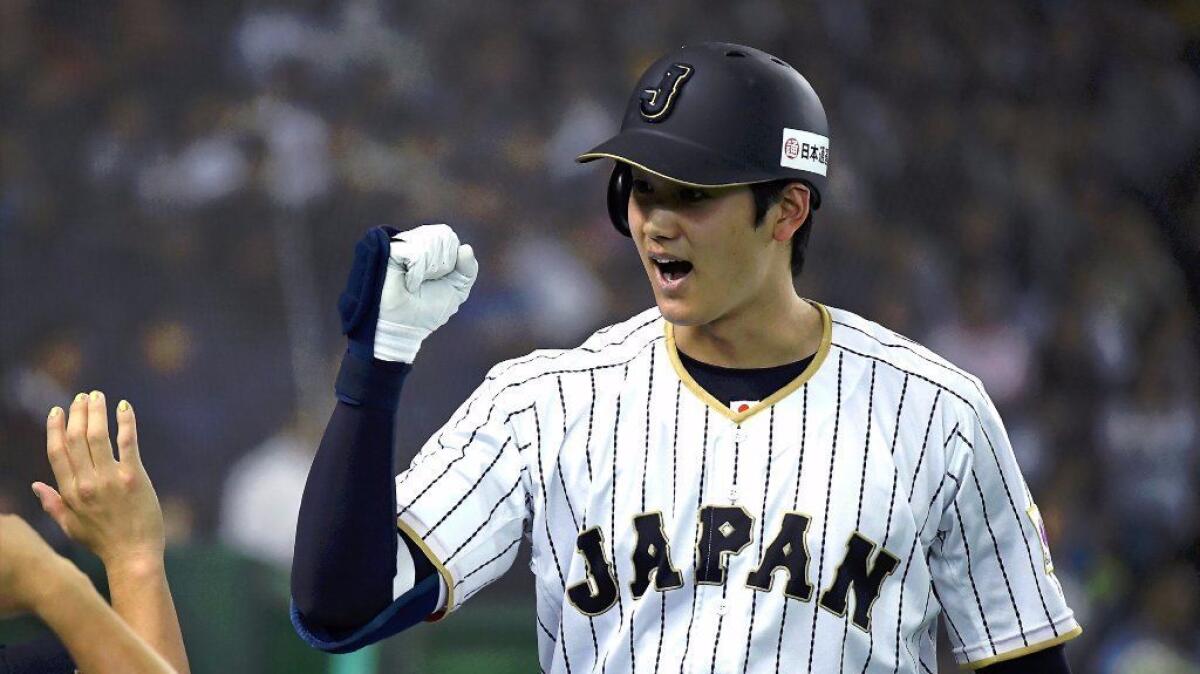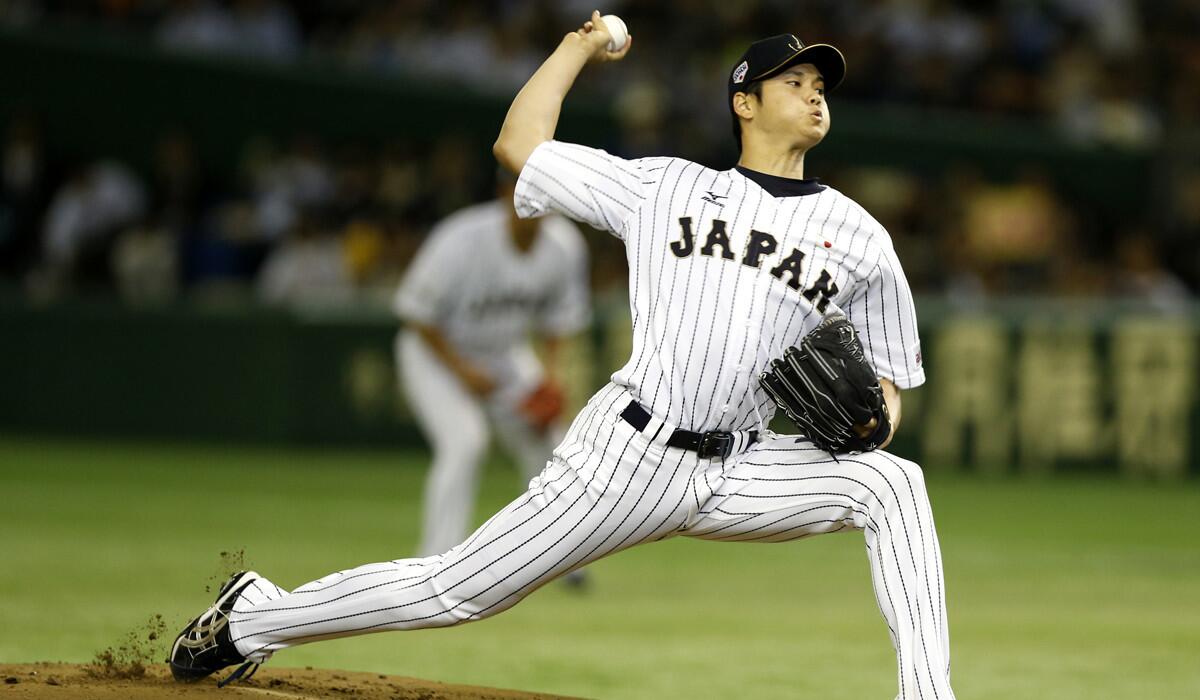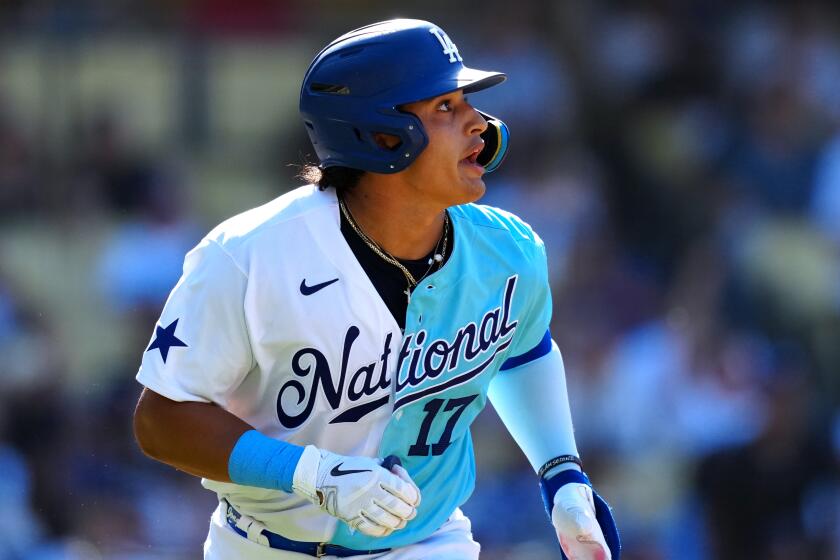Column: Dodgers can offer the two-way role Japanese star Shohei Ohtani is seeking, and a chance to win now

The economic restraint the Dodgers have exercised in recent offseasons has tempered any expectations of them landing the kind of superstar who could energize their market.
That could be about to change.
Shohei Ohtani, the 100-mph fastball-throwing, 500-foot-home-run-hitting 23-year-old from Japan, is coming to the major leagues.
From a distance, the Dodgers don’t appear to be the most welcoming of franchises for a player of Ohtani’s caliber. They haven’t signed a player to a nine-figure contract in the three-plus years with Andrew Friedman as their president of baseball operations. They have minimized the value of starting pitching. They have put a premium on platoon players with positional versatility.
Ironically, this quantity-over-quality approach of the front office is why the Dodgers are in prime position to sign Ohtani, who is the most talented player available this offseason. They can offer him what he wants, perhaps even more.
The front office will continue monitoring Ohtani’s situation this week while at the general managers meetings in Florida, as the new rules governing the transfers of players from Japan are still awaiting the approval of the players’ union.
Whatever the details of the final agreement, the Dodgers are expected to be able to offer Ohtani a bonus of only $300,000 as part of a penalty for how much they spent on amateur players in previous signing periods. Some teams can offer between $3 million and $4 million. Fortunately for the Dodgers, finances shouldn’t be a major factor in Ohtani’s decision.
If it did, he would have remained in Japan for another two years, which would have made him exempt from the economic restrictions that will be imposed on him this offseason. Delaying his move to the 2019-20 offseason would have presented him the opportunity to sign for more than $200 million. Wherever Ohtani signs this offseason, he will have a standard minor league contract that pays him the major league minimum as a rookie.
As for what Ohtani wants, clues were offered in a news conference Saturday, a day after the Nippon-Ham Fighters announced he would be made available to major league teams this offseason. Ohtani sounded as if he was looking for a team similar to the Fighters, a franchise with a clear plan on how to develop him into a player who expands the boundaries of what is possible in this game.
The majority of major league teams value him more as a right-handed pitcher than a left-handed hitter, but Ohtani said his preference would be to remain a two-way player. He mentioned how he wasn’t the only person invested in that, speaking with gratitude about the small group of people who believed he could perform both roles as a professional and of the fans who enthusiastically supported his efforts.
“There’s a part of me that feels it’s not just mine,” he said in Japanese.
The ever-modest Ohtani said he would listen to what major league teams have to say on the issue — after all, he pointed out, “If there isn’t a place that will let me [play both ways], I can’t do it” — but also made clear he wouldn’t allow himself to be pushed around.
As long as you’re playing baseball, I think it’s natural to want to be the No. 1 player
— Shohei Ohtani

Shohei Ohtani pitches against South Korea during the first inning of Japan’s semifinal game at the Premier 12 world baseball tournament at the Tokyo Dome.
“It’s a reality that I think I can have confidence in what I accomplished over the last five years,” Ohtani said. “I have a lot of confidence in what I learned.”
He was unambiguous when asked what he would like to accomplish in the major leagues.
“As long as you’re playing baseball, I think it’s natural to want to be the No. 1 player,” he said.
Ohtani nearly signed with the Dodgers out of high school as a pitcher, only to be talked into staying in Japan by the Fighters, who presented him with a detailed outline of how they would make him a world-class two-way player. As a small-market team with modest expectations, the Fighters could afford to experiment and grant Ohtani the time necessary to find his way on the mound and in the batter’s box.
A big-market team with World Series ambitions wouldn’t have that luxury, which could be why one of Ohtani’s trusted advisors told me in September that he didn’t think Ohtani would sign with a team like the Dodgers or New York Yankees.
Only the Dodgers don’t operate like most other big-market franchises. They welcome new ideas. They aren’t afraid to be different. If anything, they seem determined to be different. If there’s a team that would be open to devising a plan that would permit Ohtani to thrive on the mound and in the batter’s box over a 162-game season, it’s the Dodgers.
Speaking generally of two-way players and not of Ohtani specifically, Friedman said last week, “We definitely think that it’s doable for someone who’s talented enough to do both. It takes being a little creative in trying to figure out a schedule and figure out recovery days.”
When Ohtani was healthy in 2016, he was typically the Fighters’ designated hitter from Tuesday to Thursday. He spent the next two days preparing for his start and pitched Sunday. He rested Monday, which is generally a day off across Nippon Professional Baseball.
The greatest drawback of signing with the Dodgers could be the requirement to play a defensive position, which he stopped doing several seasons ago. But if Ohtani has to play in the outfield or at first base, the Dodgers could compensate for the increased physical demands on him with their unmatched surplus of starting pitching and liberal use of the 10-day disabled list, which they turned into a virtual taxi squad last season.
Clayton Kershaw, Rich Hill, Alex Wood, Kenta Maeda, Hyun-Jin Ryu, Brandon McCarthy, Scott Kazmir, Ross Stripling and Brock Stewart will return next season. Julio Urias could, too, depending on how he recovers from a major shoulder operation.
There are other teams who could present Ohtani with a similar work schedule. The Dodgers can offer more: The chance to not only win, but to win now.
More to Read
Are you a true-blue fan?
Get our Dodgers Dugout newsletter for insights, news and much more.
You may occasionally receive promotional content from the Los Angeles Times.






